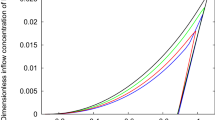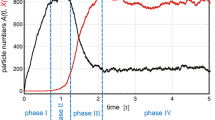Abstract
We provide a detailed, and thorough, investigation into the concentration multiplicity and dynamic stability of a prototype non-linear chemical mechanism: quadratic autocatalysis subject to non-linear decay in a continuously stirred tank reactor. This model was previously investigated in the literature using numerical path-following techniques. The contribution of this study is the application of singularity theory and degenerate Hopf-bifurcation theory to obtain analytical representations of many of the features of interest in this system. In particular, we use these presentations to identify critical values of an unfolding parameter below which specified phenomenon are no longer exhibited.




















Similar content being viewed by others
References
P. Gray, S.K. Scott, Chemical Oscillations and Instabilities: Non-linear Chemical Kinetics (Oxford University Press, Oxford, 1990)
P. Gray, S.K. Scott, Chemical Oscillations (Oxford University Press, Oxford, 1990)
S.K. Scott, Oscillations, Waves, and Chaos in Chemical Linetics, vol. 18 of Oxford Chemistry Primers (Oxford University Press, Oxford, 1994)
K.F. Lin, Concentration multiplicity and stability for autocatalytic reactiona in a continuous stirred-tank reactor. Can. J. Chem. Eng. 57, 476–480 (1979)
K.F. Lin, Multiplicity, stability and dynamics for isothermal autocatalytic reactions in CSTR. Chem. Eng. Sci. 36(9), 1447–1452 (1981)
P. Gray, S.K. Scott, Autocatalytic reactions in the isothermal, continuous stirred tank reactor: Isolas and other forms of multistability. Chem. Eng. Sci. 38, 29–43 (1983)
J.H. Merkin, D.J. Needham, S.K. Scott, A simple model for sustained oscillations in isothermal branched-chain or autocatalytic reactions in a well stirred open system. I. Stationary states and local stabilities. Proc. R. Soc. Lond. 398, 81–100 (1985)
J.H. Merkin, D.J. Needham, S.K. Scott, A simple model for sustained oscillations in isothermal branched-chain or autocatalytic reactions in a well stirred open system. II. Limit cycles and non-stationary states. Proc. R. Soc. Lond. 398, 101–116 (1985)
J. Brindley, C. Kaas-Petersen, J.H. Merkin, S.K. Scott, A simple model for sustained oscillations in isothermal branched-chain or autocatalytic reactions in a well-stirred open system. III. Multiple stationary states and \(\text{ Hopf }\) bifurcations. Proc. R. Soc. Lond. 417, 463–496 (1988)
A. Ajbar, K. Alhumaizi, Dynamics of the Chemostat: A Bifurcation Theory Approach (Taylor and Francis Ltd, London, 2012)
B.D. Hassard, N.D. Kazarinoff, Y.H. Wan, Theory and Applications of Hopf Bifurcation (Cambridge University Press, New York, 1981)
L.J.S. Allen, An Introduction to Mathematical Biology (Prentice Hall, Englewood Cliffs, 2007)
Y.A. Kuznetsov, Elements of Applied Bifurcation Theory, 1st edn. (Springer, Prentice Hall, New York, 1995)
B.F. Gray, M.J. Roberts, A method for the complete qualitative analysis of two coupled ordinary differential equations dependent on three parameters. Proc. R. Soc. Lond. 416, 361–389 (1988)
S.B. Hsu, S.P. Hubbell, P. Waltman, Competing predators. SIAM J. Appl. Math. 35(4), 617–625 (1978)
Author information
Authors and Affiliations
Corresponding author
Appendix: Globally attracting invariant region
Appendix: Globally attracting invariant region
Here we show that the region
is both (positively) invariant and exponentially attracting for any solution with physically meaningful initial conditions outside it.
We first demonstrate that solutions with non-negative initial conditions can not become negative. We have
(Observe that when \(\beta _0=0\) that the line \(\beta =0\) is itself invariant).
We now show that solutions with (physically meaningful) initial conditions outside the region \(0\le \alpha _1\le 1\) are exponentially attracted to it. From Eq. (8) we have
It follows that
i.e. the solution trajectory is attracted into the invariant region. This inequality also demonstrates that the region \(0\le \alpha _1\le 1\) is positively invariant.
We have shown that the reactant concentration (\(\alpha _1\)) is bounded. We now show that the autocatalyst concentration (\(\beta _1\)) is bounded. Let \(Z_1\left( t^*\right) = \alpha _1\left( t^*\right) +\beta _1\left( t^*\right) \) (As \(\alpha _1\) and \(\beta _1\) are both non-negative so it \(Z_1\).) Adding Eqs. (8) and (9) we have
It follows that
This inequality demonstrates that if the initial condition is within the invariant region (\(1+\beta _0 -\left( \alpha _1\left( 0\right) +\beta _1\left( 0\right) \right) >0\)) then the corresponding solution remains in it for all time. Furthermore, if the initial condition is outside the invariant region (\(1+\beta _0 -\left( \alpha _1\left( 0\right) +\beta _1\left( 0\right) \right) <0\)) then the solution is attracted into the invariant region exponentially quickly.
In the limit \(t^*\rightarrow \infty \)
As the reactant \(\alpha _1\) is bounded so is the autocatalyst. The use of simple differential inequalities to establish solutions boundedness in these types of systems stems from [15] (though was possibly known much earlier).
Rights and permissions
About this article
Cite this article
Msmali, A.H., Nelson, M.I. & Edwards, M.P. Quadratic autocatalysis with non-linear decay. J Math Chem 52, 2234–2258 (2014). https://doi.org/10.1007/s10910-014-0382-5
Received:
Accepted:
Published:
Issue Date:
DOI: https://doi.org/10.1007/s10910-014-0382-5




